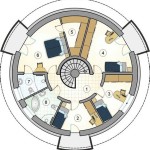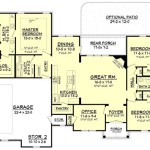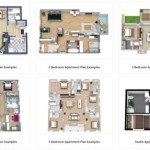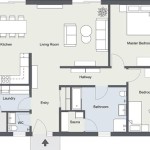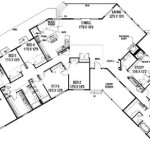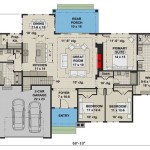Home Plans Master On Main: A Comprehensive Guide
The concept of a "master on main" home plan has gained significant traction in recent years, appealing to a broad demographic ranging from growing families to empty nesters. This design prioritizes accessibility, convenience, and long-term livability by placing the primary bedroom suite on the main level of the home. This article delves into the intricacies of master on main home plans, exploring their advantages, considerations, stylistic variations, and factors to keep in mind during the design and construction process.
Understanding the Appeal of Master on Main Designs
The core appeal of a master on main design lies in its adaptability. For families with young children, having a dedicated and easily accessible master suite offers a haven of privacy and relaxation away from the bustling activity upstairs. Conversely, as homeowners age, the elimination of frequent stair climbing becomes a crucial factor in maintaining independence and comfort. This design effectively future-proofs the home, accommodating changing physical needs and lifestyle preferences over time.
Beyond practicality, master on main designs often contribute to a more open and integrated living experience. By consolidating the primary living spaces on the main floor, these plans encourage seamless flow between the kitchen, living room, dining area, and master suite. This layout fosters a sense of connection and facilitates effortless entertaining and daily living.
Furthermore, a master on main design can enhance resale value. The increasing demand for accessible and adaptable homes makes this feature a desirable asset in the real estate market. Potential buyers appreciate the flexibility and long-term potential that this layout provides.
The accessibility of a master on main goes beyond just the bedroom. Often, these plans incorporate features like wider doorways, zero-entry showers, and strategically placed grab bars in the master bathroom, further enhancing the universal design elements of the home. This thoughtful planning ensures that the home remains comfortable and functional for individuals of all ages and abilities. Ultimately, the master on main design is about creating a home that supports a fulfilling and comfortable lifestyle, regardless of life stage.
Key Considerations When Designing a Master on Main Home Plan
While the advantages of a master on main design are evident, careful consideration must be given to various factors during the planning and construction phases. Site orientation, privacy concerns, and overall square footage are all crucial aspects that influence the success of the design.
The placement of the master suite relative to the street and neighboring properties is paramount. Adequate buffering, such as landscaping or strategic window placement, is essential to ensure privacy and minimize noise intrusion. Consideration should also be given to the orientation of the master suite to maximize natural light and views while minimizing unwanted solar heat gain.
The size and layout of the master suite itself require careful planning. The dimensions should be generous enough to accommodate comfortable movement and furniture placement. The master bathroom should be designed with functionality and accessibility in mind, incorporating features such as a walk-in shower, double vanity, and ample storage space. A well-designed walk-in closet is also a valuable addition, providing organized storage and contributing to the overall sense of luxury.
Furthermore, the overall square footage of the home should be carefully considered. While a master on main design offers numerous benefits, it can potentially increase the footprint of the home, especially if the design prioritizes single-story living. This can impact construction costs and lot size requirements. Balancing the desire for a spacious master suite with the overall budget and site constraints is crucial.
Vertical separation between the master suite and other living areas also warrants consideration. Soundproofing materials and strategic placement of hallways or buffer spaces can help minimize noise transfer and maintain privacy within the master suite. Careful attention to detail in the design and construction phases is essential to ensure that the master on main design meets the homeowner's specific needs and expectations.
Exploring Stylistic Variations in Master on Main Home Plans
Master on main home plans are not limited to a specific architectural style. They can be seamlessly integrated into a wide range of designs, from traditional to contemporary. This versatility allows homeowners to choose a style that reflects their personal preferences and complements the surrounding environment.
In traditional home styles, the master on main suite often features classic details such as crown molding, wainscoting, and hardwood floors. The layout may be more formal, with a separate sitting area or dressing room within the master suite. Exterior features often include a covered porch or veranda, adding to the timeless appeal of the design.
Contemporary master on main designs typically embrace clean lines, open spaces, and minimalist aesthetics. Large windows and sliding glass doors maximize natural light and create a seamless connection between the interior and exterior. Materials such as concrete, steel, and glass are often incorporated to create a modern and sophisticated look. The master suite may feature a spa-like bathroom with sleek fixtures and a minimalist color palette.
Craftsman-style master on main homes often incorporate natural materials such as wood, stone, and brick. The master suite may feature exposed beams, built-in shelving, and a cozy fireplace. Exterior details typically include a low-pitched roof, wide eaves, and a welcoming front porch.
Regardless of the architectural style, the key to a successful master on main design is to ensure that the master suite is seamlessly integrated into the overall plan and that it reflects the homeowner's personal style and preferences. By carefully considering the architectural details, materials, and layout, it is possible to create a master on main home that is both functional and aesthetically pleasing.
Accessibility and Universal Design Principles in Master on Main Homes
One of the most compelling benefits of a master on main home plan is its inherent suitability for incorporating accessibility features and universal design principles. Universal design aims to create spaces that are usable by all people, regardless of age, ability, or other factors. A master on main layout provides a solid foundation for implementing these principles throughout the home, ensuring comfort and convenience for all occupants.
Key accessibility features often found in master on main homes include wider doorways and hallways to accommodate wheelchairs or walkers, lever-style door handles for ease of use, and ample turning space in bathrooms and kitchens. Zero-entry showers, which eliminate the need to step over a threshold, are particularly beneficial for individuals with mobility limitations.
Grab bars strategically placed in bathrooms and near toilets provide added support and stability. Adjustable-height countertops in the kitchen allow users to customize the workspace to their specific needs. Proper lighting is also crucial, with ample natural light supplemented by task lighting to improve visibility and safety.
Beyond these specific features, the overall layout of a master on main home can contribute to greater accessibility. Placing frequently used amenities, such as laundry rooms and pantries, on the main level reduces the need to navigate stairs. Open floor plans create a more spacious and accessible environment, allowing for easier movement and interaction.
The implementation of accessibility features and universal design principles in a master on main home plan not only benefits individuals with disabilities or mobility limitations but also enhances the overall comfort and convenience for all occupants. These features can make the home safer, more functional, and more enjoyable for people of all ages and abilities.
Integrating Master on Main with Outdoor Living Spaces
The design of a master on main home plan often extends beyond the interior to encompass outdoor living spaces. Integrating the master suite with a private patio, deck, or garden can create a seamless transition between indoor and outdoor living, enhancing the overall enjoyment of the home.
A private patio or deck accessible directly from the master suite provides a tranquil retreat for relaxation and rejuvenation. This outdoor space can be furnished with comfortable seating, dining tables, and outdoor lighting to create a welcoming and inviting atmosphere. Landscaping can be used to enhance privacy and create a visual connection to nature.
Sliding glass doors or French doors can be used to create a seamless transition between the master suite and the outdoor living area. These doors allow for ample natural light and ventilation, blurring the lines between indoors and outdoors. In warmer climates, a covered patio or pergola can provide shade and protection from the elements.
For those who enjoy gardening, a small garden or courtyard adjacent to the master suite can provide a peaceful and therapeutic escape. Raised garden beds can make gardening more accessible for individuals with mobility limitations. The garden can be designed to attract birds and butterflies, adding to the natural beauty of the outdoor space.
The integration of a master on main suite with outdoor living spaces can significantly enhance the livability and enjoyment of the home. By creating a seamless connection between indoors and outdoors, homeowners can take full advantage of their surroundings and create a truly relaxing and rejuvenating living experience.
Energy Efficiency Considerations in Master on Main Designs
Energy efficiency is a crucial consideration in any modern home design, and master on main plans are no exception. Incorporating energy-efficient features and sustainable building practices can significantly reduce energy consumption, lower utility bills, and minimize the environmental impact of the home.
Proper insulation is essential for maintaining a comfortable indoor temperature and reducing heat loss or gain. High-performance windows and doors can also help to minimize energy waste. Sealing air leaks around windows, doors, and other openings is crucial for preventing drafts and improving energy efficiency.
Energy-efficient appliances, such as refrigerators, dishwashers, and washing machines, can significantly reduce energy consumption. Consider using LED lighting throughout the home, as LED bulbs use significantly less energy than traditional incandescent bulbs and have a longer lifespan.
The orientation of the home on the lot can also impact energy efficiency. Designing the home to take advantage of natural sunlight for heating and lighting can reduce reliance on artificial light and heating systems. Overhangs and awnings can provide shade during the summer months, reducing solar heat gain.
Renewable energy sources, such as solar panels, can be used to generate electricity and reduce reliance on fossil fuels. A well-designed landscaping plan can also contribute to energy efficiency by providing shade and reducing the urban heat island effect.
By incorporating energy-efficient features and sustainable building practices into the design of a master on main home, homeowners can create a comfortable, environmentally friendly, and cost-effective living space.
Main Level Master Floor Plans Dustin Shaw Homes

Main Level Master Floor Plans Dustin Shaw Homes

Master Bedroom On Main Floor House Plans Bd Downstairs

Two Story Craftsman Home Plan With Main Floor Master 86326hh Architectural Designs House Plans

4 Bedroom Contemporary House Plans With Master On Main

Master Bedroom On Main Floor House Plans Bd Downstairs

4 Bedroom Farmhouse Floor Plan Master On Main Level

Colonial Home With First Floor Master 32547wp Architectural Designs House Plans

House Plan 4 Bedrooms 2 5 Bathrooms Garage 3441 Drummond Plans

Traditional Acadian Ranch House Plan Home 142 1002

